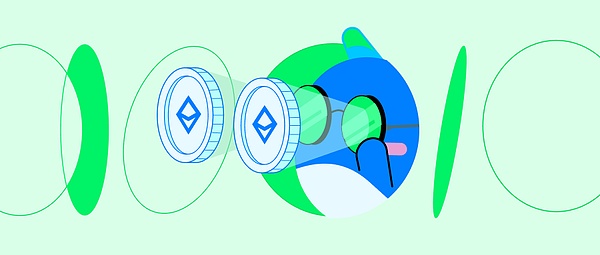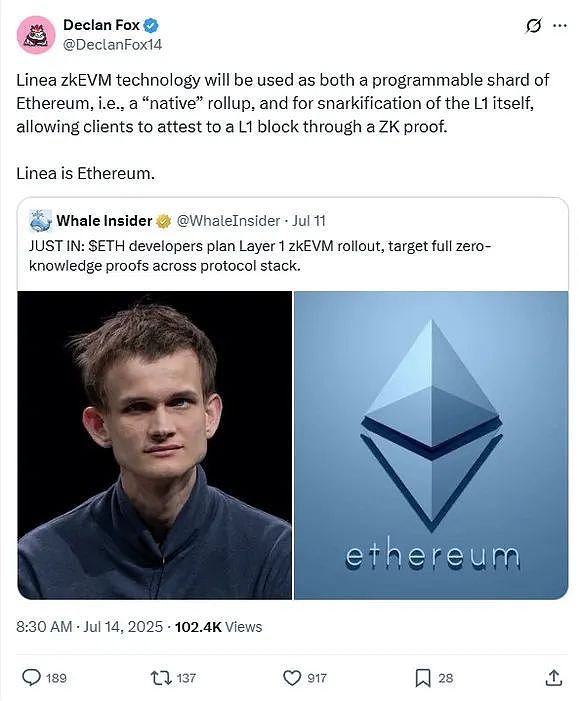
Source: Cointelegraph Magazine, compiled by imToken
Editor’s note:Ethereum is moving towards a new era of expansion of 10,000 TPS, and zero-knowledge proof (ZK) technology is becoming a key driver. This article will focus on the technical difficulties of real-time proof, Prover’s participation logic, security challenges in the L1 switching process, and how “native Rollup” can become the ultimate form of ZK expansion.

If ZKization is the starting point of Ethereum technology reconstruction, then “real-time proof” and “native Rollup” are the core implementation links of this expansion revolution.
In this article, we will continue to explore in-depth how to implement 12-second ZK real-time proof on the Ethereum main network, what is the hardware threshold and incentive mechanism for becoming a Prover, and how native Rollup will rewritten the Ethereum L2 pattern.
Real-time proof: The key puzzle for Ethereum expansion
On Ethereum’s roadmap toward 10,000 TPS, there is an indispensable technological breakthrough point: real-time proving.
Uma Roy, co-founder of Succinct, explained: “Real-time proof refers to the ability to complete the generation process of ZK proof on a block of the Ethereum main network in less than 12 seconds.”
what does that mean?Once real-time proof is implemented, Ethereum can incorporate its block verification logic into the protocol itself and almost “arbitrarily” increase the Gas cap without sacrificing verifiability, thereby achieving large-scale expansion of L1(Editor’s note: The generation time of each block on the Ethereum mainnet is 12 seconds, so “real-time” means completing the proof within each block cycle).
However, to achieve real-time proof, zkVM technology alone is not enough, and changes to the Ethereum protocol layer are also needed.
Ladislaus of the Ethereum Foundation pointed out that a key mechanism is expected to be introduced in the Glamsterdam upgrade next year – “decoupling of block verification and immediate execution”, which will provide Prover (prover) with more time to generate zkEVM proofs within a full slot, thereby achieving real-time processing in the true sense.
In terms of technical implementation, Succinct has released its latest SP1 Hypercube zkVM, which can generate proofs in real time for 93% of 10,000 mainnet blocks under a cluster of 200 GPUs.
Roy said they are confident that they will increase this success rate to 99% by the end of this year.Although some difficult-to-process blocks may still cause a very small number of blocks to fail to generate proofs in time, the protocol design has considered fault tolerance mechanisms, such as allowing the block to be skipped and the next block to continue processing.
Going further,Ethereum is also considering reducing block time from 12 seconds to 6 seconds (as another potential proposal for Glamsterdam), which will significantly improve user experience and transaction confirmation speeds,But it also puts extra pressure on ZK Prover – for the prover, the task is doubled.
However, Roy is not worried. After all, the performance of ZK technology can be improved by 10 times every year, and it can still be dealt with even if the block time is reduced by half.
In June, Linea also announced that 100% of on-chain activity on its network has been covered by ZK Proof. Although Linea currently has a TPS of only 2, this is not a performance limit, but is limited by usage requirements.
It is worth noting that the Linea block interval is only 2 seconds, and ZK proof is uploaded to Ethereum L1 verification through smart contracts. This model may be the leading version of the future “ZKization” of the main network.
Is the hardware threshold for Ethereum ZK prover high?
If you want to generate ZK proof in real time, you are of course inseparable from powerful computing resources.
The Ethereum Foundation currently sets the initial technical goals for Prover:Hardware costs are controlled within $100,000, and power consumption is less than 10 kilowatts, which is approximately the power consumption level of a Tesla Powerwall home battery.
This number doesn’t sound “lightweight”, Ethereum critic Justin Bons (founder of Cyber Capital) called it “a crazy hardware requirement far exceeding Solana’s verification nodes”, but this actually confuses two completely different roles.
Ladislaus of the Ethereum Foundation’s protocol coordination team pointed out that the responsibilities of Prover and Validator are different and cannot be confused – the verifier runs the node and participates in consensus; while Prover’s task is to generate a ZK proof. Once the ZK proof of a certain transaction is generated correctly, the network only needs to verify whether the proof is correct, without repeated execution of the transaction.
Because of this, Ladislaus expressed optimism, “As long as you can find an honest prover that meets the hardware conditions, Ethereum can continue to operate safely. We deliberately put the threshold below the data center, and even if we are not a large organization or data center, as long as we are individual developers with technical capabilities, we can run Prover at home.”
Currently, this $100,000 hardware configuration is just the initial goal. Ethereum Foundation researcher Sophia Gold expects mainstream Prover to meet standards by the Devconnect Argentina Developer Conference in November this year.
Succinct co-founder Roy expects to reduce GPU demand to around 16 graphics cards by early next year, with the total cost being between $10,000 and $30,000.
Meanwhile, Succinct has built a decentralized network of “hundreds of Provers” on the test network, generating millions of certificates.
The core logic of this system is competitive proof, i.e.All Prover participates in the bidding, and each round selects a winning bidder to perform zk proof. The goal is to make participants with shorter time and lower cost win, forming a computing power-like bidding mechanism.
This means that in the future of ZK-driven Ethereum, the spirit of miners will be reproduced in another form – just the role will go from counting blocks to counting proofs.
Mainnet cut into ZK architecture: a high-difficulty system migration
Switching the Ethereum L1 mainnet to a zero-knowledge proof-of-knowledge (ZK) architecture is another almost-the same level of technical challenge after the transition from Proof of Work (PoW) to Proof of Stake (PoS) in 2022. The entire process not only requires refactoring the protocol layer, but also requires strict consideration of various potential edge scenarios and security risks to prevent network operation from being interrupted.
At an EthProofs meeting in July this year, researcher Justin Drake mentioned several possible risks.For example, a malicious attacker may insert so-called “prover killer” into the block, causing the entire network verification mechanism to fail; or the network activity plummets, resulting in transaction fee income that is not enough to cover the cost of generating ZK proofs, thus affecting network sustainability.
Ladislaus of the Ethereum Foundation Agreement Coordination Team said the entire transition process may take several years, especially focusing on security risks.ZK Virtual Machine (zkVM) is a complex technology that is still in its early stages and is highly likely to have various vulnerabilities.However, as the ecosystem matures, we can gradually improve its feasibility and robustness in Ethereum L1 by introducing a diversified proof system, improving incentive mechanisms, and formal verification.
At the same time, Ethereum also plans to fundamentally restructure its consensus layer, that is, to build a new structure called “Beam Chain”. The goal is to optimize and friendly for ZK at the beginning of design, Drake even said thatIn the future, the entire data verification work of Ethereum will be completed on the CPU of an ordinary laptop.
Mainnet “Snarkization”: Native Rollup is coming
While integrating zkEVM on the Ethereum main network, another long-term vision has begun to gradually emerge: native Rollup (Native Rollup).
Current Rollup (whether Optimistic or ZK type) adopts an independent proof system, and its security depends on its own validator or sorter mechanism, and there is a certain trust assumption between it and the Ethereum mainnet.
The vision of “Native Rollup” is completely different –By integrating zkEVM into the main network, Ethereum L1 validators can directly verify the state transition proof of Rollup, thereby realizing L2 that is truly authenticated by the main network and guaranteed security by the main network.
This requires adding a piece of key code “execute precompile” to the Ethereum L1 client, allowing the validator to directly verify the ZK state transition proof generated by L2. As Ladislaus, Ethereum Foundation protocol coordinator, said, “L1 validators will consume these Rollup execution proofs and verify their correctness.”
In other words, if native Rollup comes true, thenIn the future, whether it is a transaction that occurs in L1 or a transaction that occurs on native Rollup, its final settlement and security are guaranteed by the same group of Ethereum validators, and the trust level will be completely equivalent.
This means that $10 million is deposited on native Rollup, and its security will be equivalent to direct deposit to the Ethereum mainnet.
Linea project leader Declan Fox said that their long-term goal is to become a native Rollup. He believes that this is an “upgraded version” of the ETH 2.0 sharding solution – no longer hard-run 64 shard chains with the same structure, but rather build a heterogeneous Rollup system in a highly programmable and customizable way to serve different scenarios and user needs.
Unlike the isomorphic sharding architecture of ETH 2.0 in the past, native Rollup can be heterogeneous, providing end users with more diverse and differentiated application experiences.
Although native Rollup has not yet been officially written into the Ethereum roadmap, with the official launch of zkEVM and the gradual reconstruction of the L1 architecture, presetting interfaces and precompiling logic for it has obviously become a foreseeable technical trend.

Ladislaus concluded that “Ethereum has a high degree of technical collaboration in the Snarkization of EVM (i.e., integrating ZK proof capability) and promoting native Rollup, because the two share the underlying ZK technology stack.” Of course, this process still needs to be formed through Ethereum community governance, form EIP (Ethereum Improvement Proposal), and finally deployed in a hard fork.
If you are optimistic, if everything goes well, you may be able to submit the relevant EIP at the end of the year and go live in the upgraded fork of Glamsterdam.
However, this timetable is still highly uncertain and needs to be viewed with caution.







